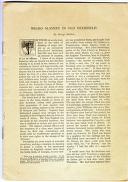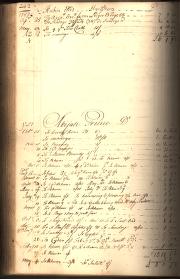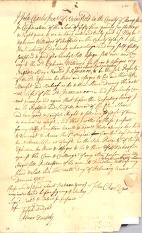|

"Negro Slavery in Old Deerfield"

Account Book of Elijah Williams, Ledger C, Vol. 4

Account Book of Elijah Williams, Ledger B, Vol. 3

Bill of sale for slave J. Romanoo

Bill of sale for slave named Prince

Bill of sale for slave named Kate

Pages from Elijah Williams (Old Soldier's) account book, Vol. 2

Pages from Rev. Jonathan Ashley's account book

"Negro Slavery in Massachusetts"

"History of Deerfield"
|
Summary and Objective
Students will understand that slavery existed in 18th century Massachusetts. They will use bills of sale and account books to compare the values of labor between slaves and whites, as well as the relative values of slaves and other commodities. They will use secondary sources from the digital collection to understand the process toward abolishing slavery in Massachusetts by 1788.
Teaching Plan
Step 1.
Pre-activity: Introduce the tradition of keeping account books between residents and entrepreneurs to record business transactions of all kinds and squaring debts, whether for labor, merchandise or real estate. Background materials that will be helpful in interpreting the account books would be: adoption of the English denomination system of (as well as symbols for) "pound", "shilling" and "pence", and measurements such as "peck". The link below on "coins" will help with images and descriptions of various 17th and 18th century coins. To help form a point of reference for comparable costs and values for us in the 21st century, furnish or ask for the current prices of: a pound of sugar, rice, coffee (and if you're brave, of rum as it's listed with abandon in the account books), and of the current minimum wage and farm workers' wages. A distinction should be made of how early New England workers labored for 12-14 hour days for their wages, rather than for the modern hourly wage. In fact, these commodities were all slave produced in the Caribbean, an irony for New England slaves purchasing the products of labor by fellow slaves. Finally, take the students through the process of using the tools of the digital collection: the original manuscripts and choosing pages from some of them, the "show text" transcription feature and, for some, the "magic lens" and "roll over" interpretive features. Whenever possible, students should work in pairs to enhance observing, questioning and interpreting.
Step 2.
In pairs, students examine the three bills of sale from the digital collection. This will help them examine values, ages and semantics of terms for slaves (such as "servant for life" and simply "Negro"), as well as the time frame involved. This should also elicit the incredulity of some students as to the existence of slavery in towns nearby to them, not just in southern colonies (and, later, states.) When the question arises, "When was slavery abolished in Massachusetts?", use the digital collection item "Negro Slavery in Old Deerfield" p.52-55 and p.58-60 to examine attitudes and the movement toward abolition.
Step 3.
In pairs, the students will examine the account books from the digital collection and list what they find: familiar items or commodities, familiar and unfamiliar names of people and why they're included, and any questions they have about terms, presentation and transactions. A guide in the use and interpretation of account books is on the John Partridge Bull link below (and in the American Centuries site.)
Step 4.
As a class, share discoveries, interpretations, hypotheses and questions, as well as the list made by each partnership. As this is done, make a comparative list of items and commodities, and of labor. Make a list of the names, particularly those of Titus, Cato, Prince and Abijah Prince who were slaves.
Step 5.
In pairs, compare the labor rates for whites and slaves, and assess the relative values of commodities and the purchase prices for slaves. Once again, remember that the long work days of 18th century laborers makes comparisons between labor rates for slaves and whites, and commodities, complicated.
Step 6.
Discuss the "Rights of Man" movement of the mid-18th century which compared the growing tremor of demands for abolition to the growing tremor of demands for independence from England. The digital collection item "Negro Slavery in Massachusetts" examines these on p.4-5, 16-17, 20, 22, 25-26 and 28-29. The other links below will provide further information of Massachusetts slave histories and cases for manumission. (Use the "mass.gov" site by selecting "b.html" through "e.html" for descriptions of various cases, including the Mum Bett and Quock Walker cases.)
Step 7.
Post-activity: Students will choose a medium, such as a newspaper editorial, a proposal for a bill before the legislature, or creating a broadsheet either to justify the continued service of slaves, or to abolish slavery.
|




